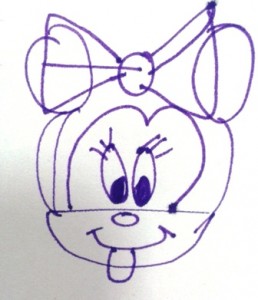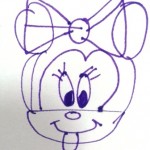For many years I firmly believed that I couldn’t draw. I remember clearly moments of humiliation from primary school teachers’ comments. I tried again as an adult with similar results! I was puzzled — I had signed up for a class to learn how to draw and yet there was no instruction. Nothing! Basically, the teacher set out objects and we were to try and draw them. I’ll never forget the night the teacher commented on my second attempt at sketching a dried poppy seed head. ‘Well, at least it’s better than your first attempt’, she said. I had taken two buses to get there for this kind of crap?! Not surprisingly, I never went back to that class!
Then my little girl came along and eventually she started to draw. She’d ask me to draw things for her and I would cringe internally at the state of my drawings! But I realised something — she was delighted I was drawing with her and totally non-judgmental about what I produced. I had to be so careful not to disparage my drawing, as I certainly didn’t want her to become self-conscious or critical of what she was creating. I wanted her to draw with abandon so I was going to have to learn to do so myself! So what did I do?
Changing myself first
I want to introduce Alison Beere, cartoon artist & teacher of beginner to intermediate cartooning online. You can check out her website at: www.alisonbeere.com. The way Alison teaches drawing is truly transformational. One day on her Facebook page, she posted a set of instructions on how to draw Minnie Mouse. I’m up for challenging my own limiting beliefs so I thought, ‘Right, I’ll have a go’. I grabbed whatever was close by and here’s the result. I was delighted with myself! It looks like Minnie! I showed it my little girl and she knew it was Minnie straight away-result!!

I actually cried when I read Alison’s feedback as my old, firmly rooted belief that I couldn’t draw was totally shaken. I had to concede I could no longer say, ‘I can’t draw.’ It would be more accurate to say, ‘I haven’t yet learned how to draw’ or ‘I haven’t practiced drawing’ — that feels so different! I haven’t spent a lot of time drawing since but my attitude has totally changed!
I wondered whether my experience was typical, and as Alison works mostly with adult beginners, I asked her to comment. Here’s what she said:
Three phrases immediately stand out for me in Mary-Pat’s story:
“I remember clearly moments of humiliation from primary school teachers’ comments.”
“I had signed up for a class to learn how to draw and yet there was no instruction.”
“My old, firmly rooted belief that I couldn’t draw was totally shaken.”
The idea that having artistic talent is something which is inborn is deeply ingrained in our Western culture and it shows up most clearly in our language. I work with adults, and many of my students gave up on drawing early on, either as a result of derogatory comments such as Mary-Pat experienced, or because they were simply told “You can’t draw”.
People don’t realise that drawing is a language that is learned, just like any other. A primary school teacher doesn’t expect a child to write until they have mastered the alphabet exercises. Why then do teachers expect children to be able to draw realistically when they have never been introduced to the alphabet of drawing?
I used to believe in inborn artistic talent — until I read a book called The Talent Code by Daniel Coyle. It was the catalyst that gave me permission to try, and I became a cartoonist and teacher as a result. I’ve now seen too many people who ‘could not draw’ start my class and come out the other end as credible artists and I know now that talent is simply skill. It is the systematic reduction of errors through understanding what works (and what doesn’t) and talent is hard-won through focused practice.
The great joy of my work teaching adults to cartoon is seeing the transformation and the childlike joy that people experience when they suddenly realise they CAN draw. It changes their whole view of themselves, and often opens them up to embrace possibility in other areas of life that they had closed down and abandoned years before.
As a result, I have realised it is incredibly important how we speak to our children around drawing and artistic talent. I’ll hand you back to Mary-Pat as the expert to help you with that…
I didn’t want to infect my little girl with my own discomfort with drawing so I did some reading. The Talent code that Alison mentioned above is excellent as is Carol Dweck’s Mindset (more on that in another post-it is startling!).
What to say?
So, we’ve all probably experienced the situation where a child comes to us & presents us with a drawing. We’re not sure exactly what it is because as adults, we assume it has to be something! We feel awkward because we don’t see something that we recognise. Usually, we say things like: ‘Oh lovely! What is it?’ Or ‘You’re a great artist!’ Or maybe a mumbled comment to another adult: ‘Abstract art, huh?’ And in return we get a puzzled look or silence. (A visitor said this in response to my little girl’s drawing- I was not impressed!!) They have twigged that we don’t get it. First of all, it’s important to remember, it doesn’t have to be anything! It’s an expression of creativity & as far as I’m concerned, there are no rules about it- don’t get me started on colouring inside the lines!
Here’s what to say when in doubt:
C: Look Mama, I drew a girl.
A: I see long hair. I like long hair. I used to have long hair when I was little.
Or
A: I see a smiley face. She looks happy to me. I feel happy looking at her.
Or
A: Oh I see you used orange. I like orange. It’s bright & cheerful. I feel happy when I see orange.
Or if it looks like a random scribble, you can describe the individual strokes that you can see:
A: I see you went dot dot dot dot, wiggle wiggle, slash, slash. I feel energetic when I see it.
Basically you describe what you see and what you feel. You don’t evaluate.
I’ve noticed with my little girl that sometimes she gets frustrated when colouring & not staying inside the lines. I see her frustration and hear her saying, “I can’t do it!” Sometimes I find this very challenging and have to resist the urge to contradict her and say, ‘“You CAN do it’!” When I catch myself about to correct her feelings, I remember to acknowledge them by saying things like “It’s so frustrating when it doesn’t go the way you want, huh?” Or I can try a little distraction like, “Oh you picked a pink pencil. I like pink.” Or I might pick a pencil and together we just scribble all over the page & forget about lines — who said it had to be within the lines anyway? Then we laugh (most of the time!).
If you like this post, please pass it on to your friends- I’d be so grateful! And you can find more interesting tips on the Facebook page- I’d be delighted if you liked it https://www.facebook.com/talknua/
See you soon!
Let’s get talking!
MP

